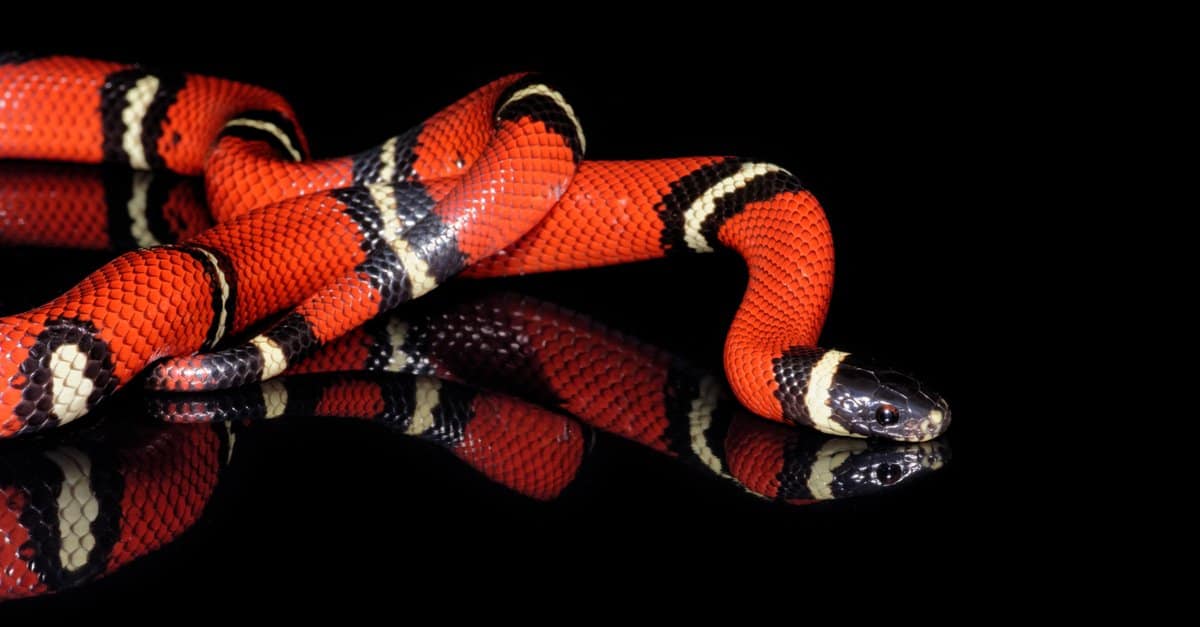Nestled between the Deep South and the Atlantic Ocean, Georgia is famous for its natural beauty. The Peach State is also home to an impressive 46 different snake species. While this may sound alarming for some, only 6 of these snakes contain venom; the rest are practically harmless to people.
That being said, there is some similarity between a few of the venomous snakes and certain nonvenomous ones. This can lead to some confusion and worry, and, in rare cases, tragedy.
Even though no snake in Georgia goes out of its way to hurt humans, that chance goes down even more if one takes the time to learn about them and is cautious in the wild. We hope to aid the people of Georgia and anyone traveling thereby giving a brief lesson on some of the snakes that call it home.
35 Non-Venomous Types of Snakes in Georgia
The following 35 snakes are all non-venomous snakes found across the Peach State:
- Brown Snake
- Eastern Hognose Snake
- Southern Hognose Snake
- Mud Snake
- Striped Crayfish Snake
- Glossy Crayfish Snake
- Black Swamp Snake
- Smooth Earth Snake
- Rough Earth Snake
- Florida Brown Snake
- Red-bellied Snake
- Eastern Ribbon Snake
- Common Garter Snake
- Common Kingsnake
- Black Kingsnake
- Mole Kingsnake
- Scarlet Kingsnake
- Ring-necked Snake
- Eastern Worm Snake
- Pine Woods Snake
- Rainbow Snake
- Black Racer
- Coachwhip
- Rough Green Snake
- Corn Snake
- Eastern Rat Snake
- Gray Rat Snake
- Pine Snake
- Eastern Milk Snake
- Scarlet Snake
- Southeastern Crowned Snake
- Florida Crowned Snake
- Eastern Indigo Snake
- Brahminy Blind Snake
- Queen Snake
We’ll dive into more details on some of the more notable snakes you’ll want to be aware of. Many non-venomous snakes look very similar to venomous ones, so by knowing the differences you’ll be able to tell if a snake is a cause for heightened concern or not.
Scarlet Kingsnake
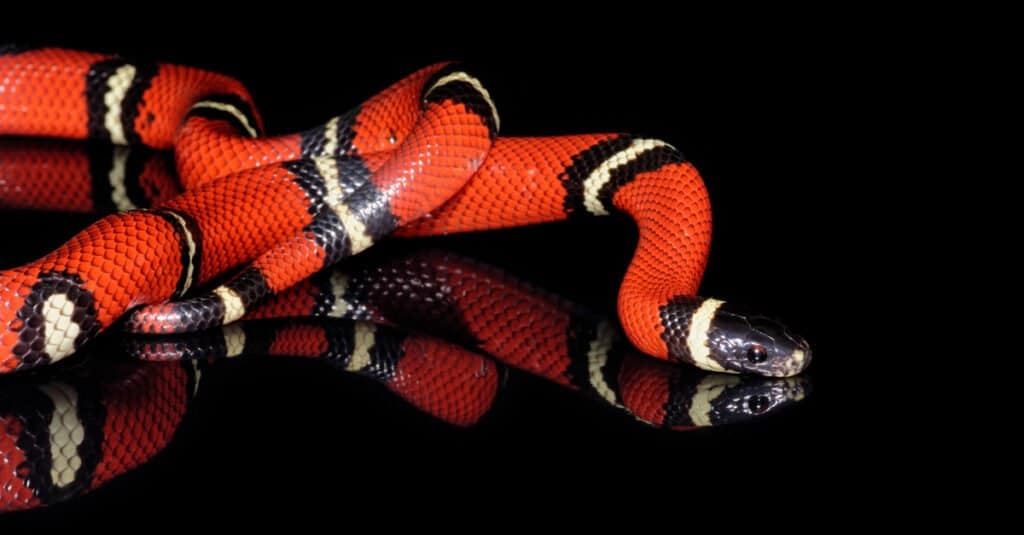
Scarlet kingsnakes have a similar appearance to coral snakes but are non-venomous.
©Valt Ahyppo/Shutterstock.com
The first of our nonvenomous snakes, the scarlet kingsnake, is especially notable. This isn’t just because of its bright, beautiful coloring, but also because it shares that coloring with a venomous, potentially deadly snake: the eastern coral snake. Both snakes have bands of black, red, and yellow.
Here’s a tip for telling them apart: the scarlet kingsnake’s red bands only touch its black ones. So if you see red and yellow scales touching each other, stay away, because it’s a dangerous coral snake. To put it differently, “Red touch yellow, deadly fellow. Red touch black, venom lack.” However, experts say that the rhyme isn’t always reliable — it only verifies that you have a normally-patterned coral snake. And, it only works in the U.S.
However, at 1.5 feet in length, the scarlet kingsnake is usually smaller than the coral snake.
Being able to tell these snakes apart is a valuable skill since they are both found all over the state of Georgia, particularly in the Coastal Plain. As for the scarlet kingsnake, their size and climbing ability allow them to be found at multiple elevations.
They inhabit wet pinelands, so you might find them up a tree, or they may be beneath logs and rocks. You may even find them on buildings. Since they eat small mammals and lizards, some people may enjoy having them around to prevent potential mouse infestations.
Eastern Rat Snake

Large adult Eastern black rat snake in defensive coiled posture on road. The snake has a shiny black body with a checkerboard belly.
©Mike Wilhelm/Shutterstock.com
Georgia is home to not just one but two types of rat snakes. The gray rat snake is the only snake found in the northwestern corner of the state while the southern coastal plain of Georgia and its Atlantic coastline is home to the eastern rat snake. In Piedmont, you may see both species. Rat snakes can grow quite large, sometimes over six feet in length.
With their large lengths, rat snakes can be intimidating, especially since they will puff up and imitate venomous snakes. Another tactic the eastern rat snake employs is emitting a foul odor to ward away would-be threats. Rat snakes are often called “chicken snakes” because of their proclivity to hunt domesticated fowl eggs. These snakes are also often confused with racers.
6 Venomous (Poisonous) Snakes in Georgia
Georgia is home to six venomous snake species. Venomous snake species in the state include:
- Cottonmouth
- Timber Rattlesnake
- Eastern Diamondback Rattlesnake
- Copperhead
- Pigmy Rattlesnake
- Eastern Coral Snake
While the first five of these venomous snakes are all vipers, coral snakes have a unique appearance in both color and body structure that separates them from other venomous snakes you’ll find in the state. Let’s dive into a few of the rattlesnakes found throughout Georgia.
Eastern Diamondback Rattlesnake

Eastern diamondbacks are the largest rattlesnake species in the world.
©iStock.com/Paulo Almeida
The first venomous snake on our list also happens to be the largest rattlesnake species in the world, reaching a maximum length of 8 feet. Realistically, though, most diamondbacks you encounter are going to be about 3 to 5 feet.
You can identify them by the two light lines on their faces, their broad heads, and, most famously, the diamonds on their backs. The diamonds are brown or black, but their interiors may be the same color as their bodies, which could be yellow, tan, or brown, and the scales surrounding them will be lighter in color.
The eastern diamondback rattlesnake is a resident of the Lower Coastal Plain, which stretches from Louisiana in the west to North Carolina in the north. Still, they are most common in the eastern states of Florida and, of course, Georgia. They inhabit dry, sandy areas, pinewoods, Flatwoods, and even coastal dunes.
Though they don’t reside in wet zones, they are capable swimmers and will sometimes migrate through salt water. Their diet consists of small mammals and birds, and they are skilled hunters, capable of striking prey that is two-thirds of their body length away.
However, for all of their prowess and feats, they are quite shy around humans and will only strike them in self-defense after being repeatedly harassed. So just listen for their rattles and keep an eye out for them during their peak hours, which are mornings and evenings in the summer months, and you should be fine.
Pygmy Rattlesnake
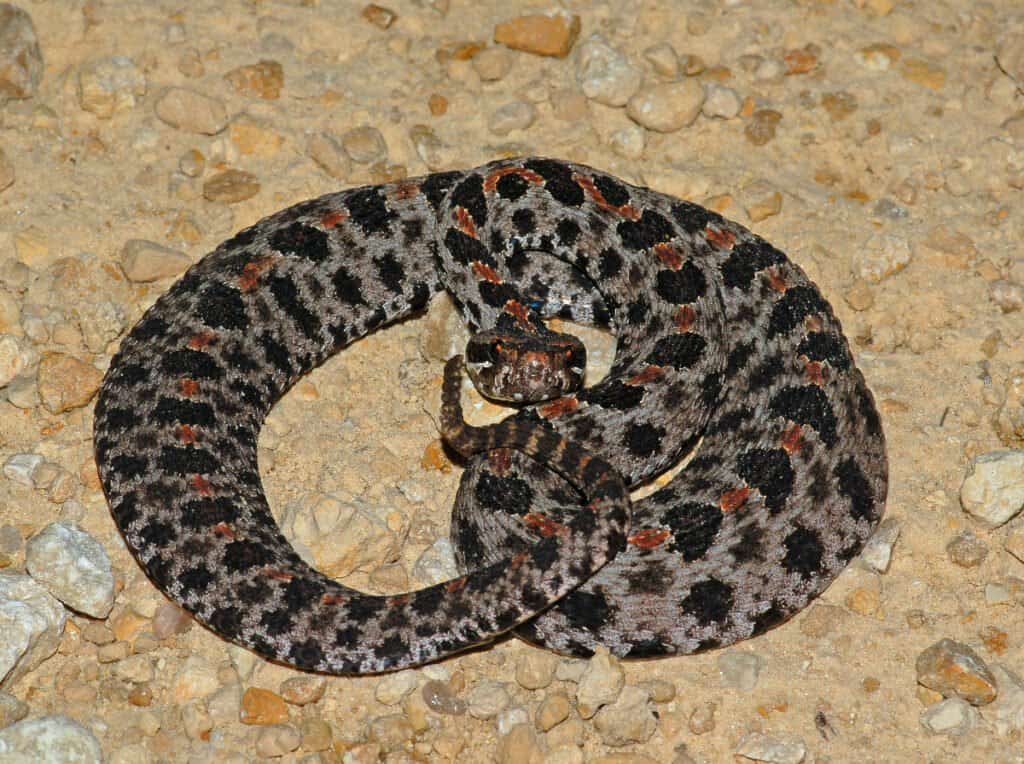
Pygmy rattlesnakes are found across nearly al of Georgia.
©Gerald A. DeBoer/Shutterstock.com
Going from Georgia’s largest rattlesnake to its smallest, the pygmy rattlesnake rarely ever exceeds 2 feet in length, though the record is 31 inches. Because of its small size, it can be harder for people to spot.
Traditionally, it’s a good idea to look for a rattle on any snake you find, so you know whether or not it’s a rattlesnake, and listening for said rattle helps you avoid them in the wild. However, like its host, the rattle on the pygmy rattlesnake is tiny! Not only does this make it harder to spot, but the rattle’s sound is very quiet and much harder to listen to.
Even still, if the eastern diamondback has no interest in humans, then the pygmy cares even less. It may occupy some harder-to-reach places, such as logs and leaf piles, but it’s simply looking for prey such as lizards and mice (and insects, in the case of their young, which are so small that their tails can pass for insects themselves).
It can be found all over Georgia, particularly around the Coastal Plain. Its favorite habitats usually have a water source, such as marshes or creeks, but it can inhibit wet or dry areas. To help you spot them, keep in mind that they may come in a variety of colors, such as gray, tan, lavender, or even orange or red.
Eastern Coral Snake
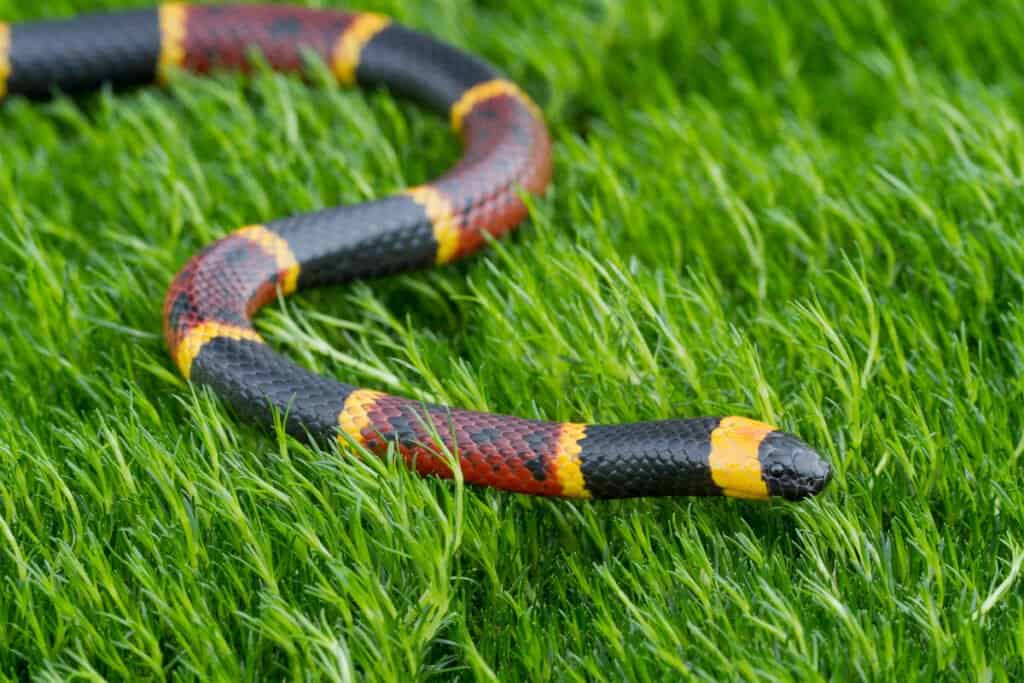
Coral snakes are only found in southern Georgia.
©Mark_Kostich/Shutterstock.com
The eastern coral snake is the first venomous snake on our list without a rattle. They are unique among the venomous snakes of Georgia, with their blunt, not diamond-shaped, heads and their bright colors of red, yellow, and black. They share these colors with the previously mentioned, nonvenomous scarlet kingsnake, leading to some confusion.
To help differentiate them, remember that the venomous coral snake’s red scales only ever touch the yellow ones, never the black. However, this is only true in coral snakes that have a normal pattern. Sometimes, snakes have what experts call an ”abberrant” pattern, leading to a snake that can be albino, solid black, or banded. Eastern coral snakes almost always have a thick band of yellow right behind their eyes and a black snout.
They aren’t the biggest snakes, reaching about 3 feet in length and weighing about 5 pounds tops. Therefore, like other venomous snakes, they won’t attack people except in self-defense. Their diet is largely cold-blooded, including frogs, lizards, and other snakes—including each other. These beautiful cannibals are sensitive to temperature, so they are most common in the spring and fall. Keep an eye open for them in Georgia’s marshes, sandy areas, coastal plains, and suburban areas.
Cottonmouth
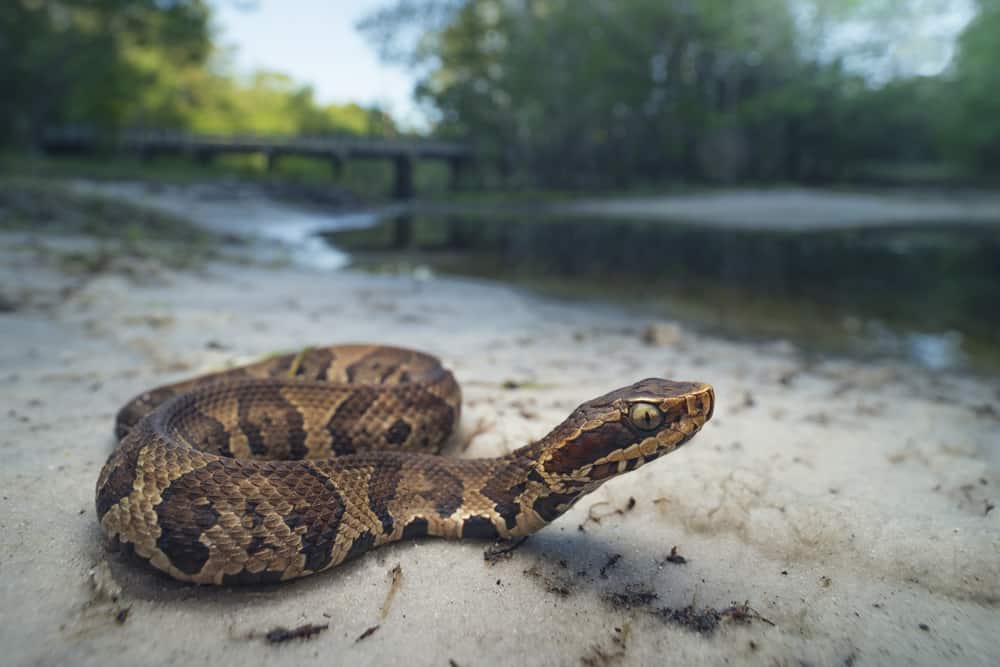
Cottonmouths are a venomous species that’s extremely comfortable in the water.
©Kristian Bell/Shutterstock.com
Though the cottonmouth gets its name for its white-colored mouth, it is known better in Georgia as the water moccasin, which comes from its semi-aquatic nature. A well-known venomous snake in the United States, it is a good swimmer and can be found in swamps, floodplains, and wetlands.
Its prey contains small animals from both wet and dry habitats; the list includes mammals, birds, insects, fish, amphibians, and even turtles and other snakes. Its presence is strongest in the southern half of the state and particularly around the Coastal Plain, but it has been known to move around, even to metro Atlanta.
Since the cottonmouth is such a well-known swimmer, some people unfamiliar with snakes assume that all swimming snakes are cottonmouths. However, knowledgeable travelers know a few ways of telling them apart from, say, water snakes.
Firstly, it is a rare sight in northern Georgia, so if that’s where you are, you’re probably safe. Secondly, cottonmouths tend to choose water habitats with lots of covers, such as swamps and streams, as opposed to an open lake or reservoir.
Thirdly, water snakes lack the colored band that is present around the cottonmouth’s eyes. Finally, cottonmouths swim with their heads well above the water, as opposed to snakes that swim while submerged.
If you’re ever unsure, just keep your distance no matter what, and the snake won’t pursue you.
5 Water Snakes in Georgia
Finally, we reach the five true water snakes found in Georgia. While cottonmouths, crayfish snakes, black swamp snakes, and many other snakes may be found in water across Georgia, each of these snakes is known for being a water snake.
In addition, all of them are non-venomous. So while the sight of a 4-foot snake swimming toward you may not be exciting, keep in mind that cottonmouths are the only aquatic snake that poses a serious risk. Here are the five water snakes in Georgia:
- Banded Watersnake
- Plain-bellied Watersnake
- Northern Watersnake
- Brown Watersnake
- Eastern Green Watersnake
Let’s take a deeper look at the northern water snake.
Northern Water Snake

Northern water snakes are the most common water snake found in Georgia.
©jmarino/Shutterstock.com
Though Georgia is home to 5 different species of water snake, the northern water snake is the most common. All water snakes are semi-aquatic, meaning that they spend time both in and out of the water, looking for their preferred prey of fish and small amphibians.
They are all adept swimmers and comfortably navigate all kinds of water bodies, including lakes, streams, marshes, rivers, and ponds. The northern water snake in particular is a common sight in the northern, more mountainous regions of Georgia.
Since this water snake can reach an average length of 3 feet and comes in several shades of brown and tan, these nonvenomous snakes are often confused with the extremely venomous cottonmouth.
While the cottonmouth is also a swimming snake, its method is distinct in that it keeps its head fully above the waterline. If a snake is more submerged, it’s probably a water snake. On top of that, the northern water snake lives in the north of Georgia, while the cottonmouth prefers the south.
A Complete List of the 46 Types of Snakes in Georgia
Here is a complete list of all 46 snakes in Georgia:
- Brown Watersnake
- Eastern Green Watersnake
- Banded Watersnake
- Plain-bellied Watersnake
- Northern Watersnake
- Eastern Diamondback Rattlesnake
- Copperhead
- Pigmy Rattlesnake
- Eastern Coral Snake
- Cottonmouth
- Timber Rattlesnake
- Coachwhip
- Rough Green Snake
- Corn Snake
- Eastern Rat Snake
- Gray Rat Snake
- Pine Snake
- Eastern Milk Snake
- Scarlet Snake
- Southeastern Crowned Snake
- Florida Crowned Snake
- Eastern Indigo Snake
- Brahminy Blind Snake
- Queen Snake
- Brown Snake
- Eastern Hognose Snake
- Southern Hognose Snake
- Mud Snake
- Striped Crayfish Snake
- Glossy Crayfish Snake
- Black Swamp Snake
- Smooth Earth Snake
- Rough Earth Snake
- Florida Brown Snake
- Red-bellied Snake
- Eastern Ribbon Snake
- Common Garter Snake
- Common Kingsnake
- Black Kingsnake
- Mole Kingsnake
- Scarlet Kingsnake
- Ring-necked Snake
- Eastern Worm Snake
- Pine Woods Snake
- Rainbow Snake
- Black Racer
How Dangerous (or Deadly) Are Snakes Of The Peach State
You may hear occasional reports that snake attacks in Georgia are “on the rise.” This is largely misleading, as snake bites still only kill 5 or 6 people per year throughout the entire country, so that amount is negligible.
If they are “on the rise,” it’s probably because of the warmer weather. Not only are people spending more time outdoors, but snakes are waiting longer to hibernate, meaning that we have more time to interact.
However, that doesn’t mean that snakes are any more aggressive than before. In fact, nonvenomous snakes are so harmless that killing them is illegal in Georgia. Even the venomous ones are more afraid of people than most are of them.
As long as people educate themselves on these beautiful reptiles and respect their habitats, they should be able to enjoy the Georgian outdoors to their heart’s content.
Other Reptiles Found in Georgia
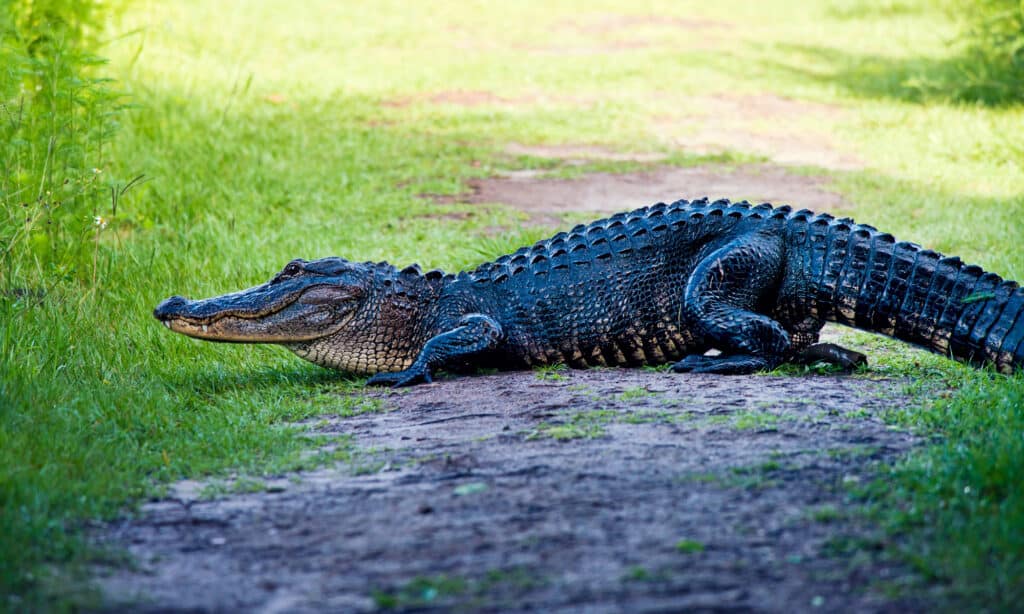
The American Alligator is a reptile that is found in Georgia.
©Svetlana Foote/Shutterstock.com
Georgia is home to a wide variety of wildlife, including over 50 species of reptiles. While many people may associate Georgia’s reptile population with venomous snakes, such as the eastern diamondback rattlesnake and copperhead, there are actually many other interesting and unique reptiles found in the state.
Here are some reptiles found in Georgia that are not snakes:
- American Alligator (Alligator mississippiensis)
- Florida Worm Lizard (Rhineura floridana)
- Green Anole (Anolis carolinensis)
- Eastern Glass Lizard (Ophisaurus ventralis)
- Mimic Glass Lizard (Ophisaurus mimicus)
- Island Glass Lizard (Ophisaurus compressus)
- Slender Glass Lizard (Ophisaurus attenuatus)
Discover the "Monster" Snake 5X Bigger than an Anaconda
Every day A-Z Animals sends out some of the most incredible facts in the world from our free newsletter. Want to discover the 10 most beautiful snakes in the world, a "snake island" where you're never more than 3 feet from danger, or a "monster" snake 5X larger than an anaconda? Then sign up right now and you'll start receiving our daily newsletter absolutely free.
Thank you for reading! Have some feedback for us? Contact the AZ Animals editorial team.

